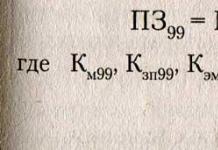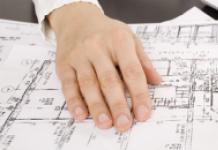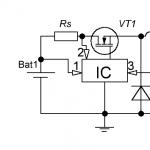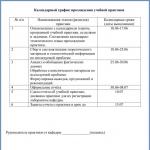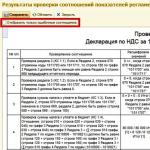General characteristics of the cost approach to real estate valuation.
The cost approach is a set of methods for assessing the value of a property based on determining the costs necessary to restore or replace a property, taking into account its wear and tear. The cost approach is based on the principle of substitution, according to which it is assumed that a reasonable buyer would not pay more for a property than the cost of constructing a property of similar utility to the property being valued.
According to the cost approach, the total cost of a real estate object (Cv) is determined as the sum of the cost of a plot of land (Suz) and the replacement cost (cost of replacement or reproduction) of a real estate object (Cvs) minus the accumulated depreciation (Ciz):
Application of the cost approach to real estate valuation consists of the following steps:
· assessment of the market value of the land plot;
· assessment of the replacement cost (replacement cost) of the building being assessed, incl. assessment of the amount of business profit;
· calculation of identified types of wear;
· calculation of the final value of the appraisal object by adjusting the replacement cost for wear and tear, followed by increasing the resulting value by the cost of the land plot.
Determining the value of a plot of land included in the real estate assessed by the cost method is based on the assumption of its best and most effective use as free from development.
To assess the market value of land, the following methods are used:
· sales comparison method;
· distribution method;
· selection method;
· method of dividing into sections;
· residue technique for land;
· capitalization of net land rent.
The sales comparison method, when critical information is available, is the most preferred and generally applicable method. The main elements of comparison for land are:
· property rights;
· financing conditions;
· terms of sale;
· market conditions;
· location;
· physical characteristics;
· available utilities;
· zoning conditions;
· best and most effective use.
When valuing land, you can use multiple units of comparison, adjusting the price of each unit and ending up with multiple values that define a range of values.
The distribution method is based on the assumption that for each type of real estate there is a normal relationship between the value of land and the value of buildings. This relationship is most reliable for new improvements that reflect the best and most efficient use of the land.
In theoretical terms, the full replacement cost of buildings is usually understood as a cost estimate, the cost of constructing a copy of the building being assessed as of the valuation date.
The assessment of the full replacement cost of a building as of the valuation date can be made at the cost of reproduction or at the cost of replacement.
The cost of reproduction represents the cost estimate for the construction of an exact copy of the appraised building, taking into account all its shortcomings and redundant elements at current prices on the appraisal date, using the same building materials, standards, design, design, quality of work, etc.
Replacement cost is the estimated cost of constructing a building of equivalent utility to the property being assessed, using modern building materials, technology, current standards, design and design.
The total replacement cost of buildings includes direct and indirect construction costs, as well as business income.
Direct construction costs include the full estimated cost of construction and installation work, which, in turn, includes direct and overhead costs, as well as the profit of the contracting construction organization.
Indirect costs include expenses necessary for construction, but not included in the construction contract. Indirect costs may include:
· design and survey work;
· valuation, consulting, accounting and legal services;
· financing costs through a loan;
· insurance of all risks;
· tax payments during construction, etc.
Entrepreneurial income is part of the market value of a building, which represents the amount of entrepreneurial profit arising during the implementation of construction work, compensating for the risks arising and realized upon a change of owner. Business income (actually realized) is defined as the difference between the sale price or market value of the object and total costs.
The total replacement cost (TRC) of the improvement is determined by the formula:
Full replacement cost of buildings. - concept and types. Classification and features of the category "Full replacement cost of buildings." 2017, 2018.
Replacement cost is the cost of fixed assets, adjusted from the original value as a result of the revaluation of the object. Current legislation allows commercial organizations to regularly (no more than once a year) review the cost of fixed assets, focusing on changes in market prices and taking into account projected inflation.
The possibility of property revaluation exists for both fixed assets and intangible assets (intangible assets). The application of this norm is regulated by PBU 6/01 and PBU 14/2007, although in relation to intangible assets the legislator uses the term “current market value” with an approximate meaning to the concept of “replacement value”. Let's talk about how to calculate the replacement cost of fixed assets and what you should pay attention to.
Initial and replacement cost of fixed assets
Production assets serve for a long time, gradually wearing out and transferring their value to the finished product. Therefore, their accounting is structured so that you can immediately see the initial price of the object, its gradual loss (wear and tear) and the residual value. There are three costs of fixed assets: initial, residual and replacement.
The initial cost reflects the real costs of acquiring property (price of the object + costs of installation, transportation, etc.). It does not change, unless we are talking about reconstruction, completion or partial liquidation of the facility. The loss in value of assets is reflected in their valuation at residual value. This is the original cost reduced by the amount of wear and tear.
Over time and under the influence of an ever-changing market, the original cost no longer corresponds to the actual value of the property. Therefore, the question arises of restoring the price to reflect market realities. Such compliance is achieved through revaluation, and the value of the revalued asset becomes replacement value.
Original replacement and residual value
Let's talk in more detail about the categories of replacement cost. The cost of modern analogues of assets in relation to already used objects subject to revaluation is the full replacement cost. And since operating assets are already worn out to some extent, their restored value cannot be full, but only close to the market value and taking into account accrued depreciation.
And here the concept of original restored value is relevant. Those. after the revaluation of the object, its initial value becomes the initial replacement value, i.e., the original price of the asset at the current moment.
The revaluation rule is the proportional distribution of the increase (or decrease) in value to the asset itself and its depreciation, i.e. not only the price of the object is recalculated, but the amount of depreciation on it. The recalculated cost minus depreciation will be called the residual replacement cost.
How is the replacement cost of fixed assets determined?
To determine the replacement cost of an asset, different methods are used. Analyze:
- prices for similar objects according to manufacturers and trade organizations;
- information from statistical authorities,
- expert opinions on the current cost of similar operating systems.
The “new” cost of objects is established by indexing or direct recalculation based on data for similar products. As a rule, appraisers are involved in revaluation, who revaluate each object, taking into account all market criteria and depreciation of assets.
The revaluation procedure is preceded by a lot of organizational work. Necessary:
- select OS objects that will be revalued;
- enter into an agreement with a licensed appraiser;
- issue an order to conduct a revaluation, which should include a list of the property being valued. It states:
Name of objects;
Dates of their acquisition/manufacturing, commissioning.
The main criteria for determining the replacement cost of fixed assets for revaluation are:
Initial or current value (if the object was previously revalued) at the beginning of the reporting year;
Depreciation accrued over the period of operation of the facility.
Pursuing the goal of approaching the market value of fixed assets, revaluation regulates the original value, so the result of revaluation may be an additional valuation or a discount of funds.
Replacement cost: formula
Having established the value of the full replacement cost, it is possible to determine the replacement cost of fixed assets after revaluation. It is found by multiplying the total replacement cost by the ratio of the residual value to the original value (before revaluation). According to the formula:
C in = C p x K ots, where
C in – replacement cost of the object,
C p – initial cost,
K ots – evaluation coefficient.
Example
According to a specialist, the initial cost of the machine (RUB 100,000), which has been operating in the enterprise for 3 years (36 months), has decreased by 30% compared to market analogues. When revaluing the asset, a coefficient of 1.3 was applied and the replacement initial cost of the object was calculated:
C in = 100,000 x 1.3 = 130,000 rub.
To be fair, we note that the correction factor is not always used. The replacement cost of an object can be determined based on an analysis of the market situation and the price of analogue products, confirmed by documents.
Let's go back to the example:
After establishing the price of the machine at the current moment, it is necessary to calculate its current residual value. Let's calculate it using the formula:
C ov = C pv x C ost / C per, where
C ov – residual replacement cost,
C pv is the full (initial) replacement value, and C ost and C per are the residual and initial costs of the asset before revaluation.
Let’s assume that the service life of the machine established in the organization is 8 years (96 months). Then
C rest = 100,000 – (100,000 / 96 x 36) = 100,000 – 37,500 = 62,500 rub.
Let's substitute the values into the formula:
C ov = 130,000 x 62,500 / 100,000 = 81,250 rubles.
Thus, the initial replacement cost of the machine on the day of revaluation amounted to 130,000 rubles, its current residual value increased from 62,500 rubles. up to 81,250 rubles, and accrued depreciation amounted to 48,750 rubles. (130,000 – 81,250) instead of 37,500 rubles. before revaluation.
The building (structure) of a potato storage facility located in the suburbs of St. Petersburg was selected as the object of assessment. Valuation date (provisional) - January 1, 2000
Description of the valuation object:
The facility is a working potato storage facility with storage facilities.
The building is detached, has a rectangular shape, year of construction - 1970, capital group - 2, number of floors - 1.
Total area assessed:
- building plan - 532 m²;
- usable area - 480 m². The height of the building is 4.5 m. The construction volume is 2394 m³.
Information about the design features of the building:
- foundation:
under the columns - reinforced concrete, glass type,
under the walls - strip, prefabricated reinforced concrete blocks;
Columns - reinforced concrete;
- external walls - brick;
- load-bearing structures - full reinforced concrete frame;
- floors - prefabricated reinforced concrete slabs;
- gates - wooden;
- partitions - brick;
- roofing - soft roll in three layers;
- floors - concrete.
Engineering networks- electric lighting, ventilation (natural). For the object under consideration: territorial zone - 1 (first), climatic region - 2 (second), industry - agriculture.
Let's consider calculating the replacement cost of improvements to the property being assessed using all four methods: base-index, resource, modular and comparative unit method.
As an appendix, we give a classification of buildings into totality groups depending on the material of capital structures: foundations, walls and ceilings (Tables 11.2, 11.3):
1. Calculation of replacement cost using the basis-index method
The last time basic prices in construction in our country were established in 1991 (SNiP 4.03.91). In practice, estimates for construction and installation work are often compiled in base prices of 1984, since the regulatory documentation (SNiP IV-4-82) was developed in the most detail. In addition, regional indices for converting estimated costs from base to current prices, which are developed in St. Petersburg by the Regional Center for Pricing in Construction of St. Petersburg, are determined specifically for conversion from the base level of 1984. These indices are published in the monthly bulletin “Stroyinform SPb. "
According to the standards of 1984 and those currently in force, the estimated cost of building a facility is determined by a consolidated financial calculation, including 12 chapters:
Chapter 1. Preparation of the construction site (cost rate - 1-10%).
Chapter 2. Main construction objects.
Chapter 3. Objects for auxiliary and service purposes. Chapter 4. Transport and communication facilities. Chapter 5. Energy facilities. Chapter 6. External networks and structures.
Chapter 7. Improvement of the construction area and landscaping (in total, the infrastructure of the facility in Chapters 3-7 has an approximate cost rate of 3-30%).
Chapter 8. Temporary buildings and structures (usually regulated by 1-4% of the amount of chapters 1-7).
Chapter 9. Other work and costs (usually about 4-10% of the amount of chapters 1-8):
- increase in the cost of work in winter (1.5-3.5%) of the amount of chapters 1-8;
- road use tax (approximately 2.5%) of the amount of chapters 1-12, etc.
Chapter 10. Contents of the directorate (technical supervision), designer supervision (from the sum of chapters 1-9):
- technical supervision (on the part of the customer) 3-5% of the amount of chapters 1-9;
- designer's supervision (on the part of the designer) 3-10% of the amount of chapters 1-9.
Chapter 11. Training of operational personnel (the chapter is introduced if there is a need for specially trained personnel, it is not standardized or regulated. It may be absent if the object is typical).
Chapter 12. Design and survey work. Depending on the amount of direct costs, usually about 1.5-11% of the amount of Chapters 1-11.
The calculation is based on Chapter 2, which includes data from local estimates (estimates) for certain types of construction and installation work: excavation work, foundations, walls, floors, openings, roofing, etc. To compile local estimates, EPEP-84 and collections of average regional estimated prices for materials, products and structures are used (Appendix to SNiP IV-4-82). Currently, the RCSC has developed a new base for 1998-1999. — PRS-98, PRR-98, PRM-98, EPC-99, ERR-99, ERM-99.
Calculation sequence
1. Data from calculations of local estimates are grouped by elements of direct costs: materials (M84), basic wages of main workers (ZPM) and operation of machinery and mechanisms (EMiM84).
2. Direct costs are determined in current prices:

3. The overhead costs and contractor's profit by region are determined. Moreover, overhead costs can be determined from direct costs or from the wage fund (payroll) as a percentage.
Overhead costs in accordance with the recommendations of the Regional Center for Pricing in Construction of St. Petersburg from the payroll are determined by the formula

The contractor's profit rate is set by the Russian State Construction Committee at 12% (8% for the 1984 base).
4. By summing up the above costs, the cost of construction and installation work is determined (result of Chapter 2) V.
5. According to the design and estimate documentation, the costs of creating the infrastructure of the facility are determined (Chapters 1, 3-7).
6. Costs for Chapter 8 are determined according to the standards based on the total for Chapters 1-7 (temporary buildings and structures).
7. Costs for Chapter 9 are determined according to the standards based on the total for Chapters 1-8 (winter price increases and other costs).
8. Costs for Chapter 10 are determined according to the standards based on the total for Chapters 1-9.
9. Costs for Chapter 12 are determined according to the standards based on the total for Chapters 1-11.
10. By summing the costs of chapters 1-12 and plus VAT, the cost of construction of the facility is determined.
Additional indirect costs for the developer are estimated to be in the range of 0.5-10% of the costs for chapters 1-12.
Then the replacement cost of improvements to the property is determined by increasing C by the amount of business income (BI).
When using the base-index method, construction cost calculations were carried out in base prices of 1991 on the basis of aggregated indicators of base costs by type of work (UPBS BP).
The transition from base 1991 prices to current ones was carried out using price increase indices (index method), and the latter, in turn, were determined taking into account actual exchange prices for materials and energy resources. When calculating by the index method, the cost indicators of resources were taken according to the RCCS data on the date of the assessment - January 1, 2000.
Calculations were performed in Excel spreadsheet environment using the AWP-estimator program Ar-Pro-2.0. The calculation results are shown in the table.
Thus, the replacement cost of improvements to the property being assessed, calculated using the base-index method, is rounded to RUB 877,000.
2. Calculation of replacement cost using the resource method The sequence of calculating replacement cost using the resource method:
1) according to the design documentation, technical passports or full-scale measurements, the consumption of basic building materials, products and structures for a given building is determined;
2) the current cost of building materials, products and structures is determined on the valuation date according to data from small wholesale and wholesale trade enterprises in St. Petersburg;
3) the costs of paying the main workers and operating construction machinery and mechanisms are calculated, taking into account the average statistical data on construction in a given region. It is taken into account that labor costs for buildings made primarily of prefabricated elements are lower than for buildings made of cast-in-situ concrete or brick;
4) the costs of overhead costs and the contractor’s profit for a given region are determined:
HP = (Zs + Zm) x In: 100,
where In is the standard overhead costs from the wage fund, which is, depending on the type of construction of the facility, for the entire complex of works by type of construction: industrial - 92%, residential and civil - 94%, large-panel and volumetric block housing construction - 143% , transport - 86%, water management - 84%, energy engineering - 93%, agricultural - 94%, other industries - 90%.
The contractor's profit rate: for residential and civil construction - 11%, industrial - 10.7%, agricultural - 11%, other industries - 11% (StroyInform. 1999. No. 7);
5) the replacement cost of construction and installation work is determined by summing up the above costs;
6) the costs of creating the infrastructure of the facility are calculated (external networks, preparation of the construction site, landscaping, design and survey work, etc.);
7) taking into account infrastructure costs and VAT, the cost of construction of the facility is calculated;
8) the replacement cost of improvements is determined by an increase in construction by the amount of business income.
The calculation results are shown in the table
Thus, the replacement cost of improvements to the property being assessed, calculated by the resource method, is rounded to RUB 888,000.
1. Calculation of replacement cost by the comparative unit method is based on comparing the cost of a unit of consumer properties (1 m² of area, 1 m³ of construction volume, 1 parking space, etc.) of the object being valued with the cost of a similar unit of measurement of a similar standard object.
When applying this method, to determine the replacement cost, unit cost indicators taken from special reference books and collections are used. The normative basis of the method under consideration includes the collections “Integrated indicators of replacement cost” (UPVS). These collections contain data on the replacement cost of typical objects (units of consumer properties) according to information for 1969.
When carrying out calculations, an electronic program (written on the basis of UPPVS collections) was used to find and analyze typical objects, and further adjust for differences in design solutions from the object being assessed.
The adjustment to the valuation date was carried out using indices (deflators) published quarterly by the Regional Center for Pricing in Construction of St. Petersburg. This adjustment is made by double recalculating prices from 1969 to 1984 and from 1984 to the valuation date.
Next, an adjustment was made for differences in the composition and types of engineering equipment.
During the calculations, several options for analogous objects (greenhouses) were selected and considered, similar in their purpose, design solutions, composition and types of engineering equipment. Of these, one analogue was finally selected as a standard one.
Adjustments were made to the analogue object for differences from the appraisal object and to bring the adjusted value of 1969 to the valuation date - January 1, 2000.
Thus, the replacement cost of improvements to the property being assessed, calculated on the basis of aggregated indicators of replacement cost using the comparative unit method, is rounded to RUB 826,000.
4. Calculation of replacement cost using the modular method
When using the modular method, the selected resource indicators were also selected as of the specified valuation date.
Brick walls are selected as the main structural module for calculating the cost of the object under consideration - a potato storage facility.
The calculated volume of brickwork is 177.7 m³.
Direct costs are calculated for this module using the resource method in the approach; calculations are made using the resource method, since they use price market information for the specified date.
According to the data sheet for the structure in question - a potato storage facility - the share of the calculated module (brick walls) in the cost of the entire facility is 32%.
Then the cost of the entire object: 289,358: 0.32 = 904,243 rubles.
Thus, the replacement cost of the appraisal object, calculated by the modular method, is rounded to 904,000 rubles.
The summary table of the results of calculating the replacement cost of potato storage improvements is as follows:
Calculations carried out using the modular method, although they use current market data (prices), but only partially, for a separate module, and the final cost is determined by a specific percentage in the cost of the entire object. Therefore, we can consider the accuracy of the results obtained by this method to be somewhat lower than when calculating using the resource method, although in absolute terms the value of the estimated value was the largest among all the considered valuation methods.
Comparative unit method and basis-index method are based on the selected basic price level for resources, reduced to the current (as of the valuation date) level, by indexing data on the valuation object. This leads to a relatively larger error in the calculation results (especially for the comparative unit method) in relation to the calculation by the resource method.
Based on the above, we can conclude that calculating the replacement cost of improvements using the resource method provides the most accurate estimate of the cost, but this is the most labor-intensive method of all those considered.
The replacement cost of improvements to the property being assessed, determined by one of the methods, is the basis for determining the market value using the cost approach. It is from the level of replacement cost (or replacement cost) of improvements, simulating their value as if they were new on the valuation date, that cumulative depreciation is calculated, allowing the resulting assessment of improvements in their actual condition on the valuation date.
However, replacement cost is the basis for the calculation and costing of the cost approach. In this case, the costs of recreating (reproducing) the assessed improvements to the facility as of the valuation date are calculated using not market, but contract prices and estimated prices for construction and installation work, wholesale prices for building materials, fuel, energy, machinery, equipment, inventory and etc. Information about specific or individual cost indicators should also be of a contractual, regulatory, calculated (in fact) nature, and not of a market nature. At the same time, all parameters of operational qualities inherent in this facility are preserved (taking into account ergonomic, sanitary-hygienic, environmental and other standards in force at the time the building/structure was put into operation).
Finally, the appraiser must be aware of which of the two costs he is assessing - restoration or replacement - motivate his choice and consistently track its implementation (based on relevant changes in the project, set of structural elements, equipment models, etc.). At the same time, when choosing replacement cost as a basis for calculating the cost approach, it is necessary to provide evidence that the model used for valuation actually has equivalent utility to the object being valued.
Replacement cost (the cost of reproducing an object) is determined by the costs in current prices for the construction of an exact copy of the valued object in its “new” state (excluding wear and tear), using the same architectural solutions, building structures and materials, as well as with the same quality of construction. installation work. In this case, the same obsolescence of the object and the same shortcomings in architectural solutions that the assessed object had are reproduced.Replacement cost is determined by the costs at current prices for the construction of a property that has equivalent utility to the one being assessed, but built in a new architectural style using modern design standards and advanced materials and structures, as well as modern equipment of the property.
Which of the two costs (replacement or replacement) to accept to determine the value of the object being valued is decided by an expert appraiser based on the possibilities of implementing one or another calculation method in a given specific situation. However, from a practical point of view, it is more preferable to use the replacement cost, since replacement creates an object that is different from the one being valued.
There are four main ways to determine the replacement cost of a property.
1. Based on the estimated construction cost, or quantitative analysis method.
Construction estimate - a documented plan for the receipt and expenditure of funds to finance construction costs.
This method consists of drawing up estimates for the construction of a given object, as if it were being built again. First, you need to make a quantitative list of all materials and equipment and calculate the labor costs required to install each element, i.e., determine direct costs. To these must be added indirect costs (insurance payments, interest and taxes paid during construction, architects' fees, management expenses, etc.), as well as the developer's profit.
This is the most labor-intensive method of determining the value of an object, although it can be significantly simplified if the old estimates for which the object was built have been preserved for the object being valued. Otherwise, the expert appraiser will need the help of a specialist estimator who develops estimates for the property being assessed using the Unified Standards and Prices and Price Indexes for Construction and Installation Work.
Construction and installation works (CEM).
Basic salary for construction workers.
Cost of materials, semi-finished products, parts and structures.
Costs of operating construction machinery and mechanisms.
Total direct costs (DC)
Overhead (OOP)
Total contractor costs (cost C = PZ + NR)
Planned savings (PN)
Total price of the contractor (replacement cost of construction and installation work Sv_smr = C + PN)
Costs for the purchase of engineering equipment (EO).
Other developer costs associated with construction.
Costs for design estimates and survey work.
Costs associated with land acquisition.
Costs by customer functions.
Payment of lawyers and other consultants.
Insurance payments.
Taxes.
Selling expenses.
Ongoing expenses from completion of construction to sale.
Other expenses.
Total other developer costs (OPC)
Total costs of the developer (ZZ = St smr + ZO + PZZ)
Developer's profit (PrZ)
Total cost of the object (St about = ZZ + PrZ)
Index method.
It provides for an adjustment of the book value to the corresponding index in accordance with the Regulations on the procedure for revaluation of fixed assets (assets) of enterprises and organizations, approved by Decree of the Government of the Russian Federation No. 1233 of November 25, 1993. Indices for the revaluation of fixed assets are approved by the Government of the Russian Federation and are periodically published in the press.
Comparative unit method.
A method of estimating construction costs by multiplying the adjusted cost of the unit selected for real estate calculation (taken as a guide) by the number of units of the property being assessed. Units of measurement can be 1m2, 1m3, 1 place, etc. If the expert appraiser cannot find a recently built comparable object, you can use the developments of the Central Research Institute of Economics and Construction Management, which produces specific cost indicators per consumer unit of construction products for specific types of buildings and structures at baseline, current and forecast price levels based on quarterly resource prices.
4. Method of breaking down into components.
This method uses cost indicators for individual building components, including their installation (costs of excavation, installation, finishing, etc.).
In the theory of valuation activities, the replacement cost of buildings is interpreted as the cost of constructing a building - the subject of valuation on a specific date. In the process of assessing real estate, the problem of assessing obsolete materials and building elements that do not comply with current construction standards arises. In these cases, the cost of constructing a building (estimate) with similar utility is calculated. In this case, the estimator has a cost estimate based on replacement cost. Estimates may vary in terms of replacement cost, as well as the degree of wear and tear.
A building is valued at replacement cost using either replacement cost or replacement cost. The expert must explain the choice of cost type for a specific task in the report for a correct understanding of the final cost result.
Reproduction cost is the estimated cost of constructing a replica of a building using the same materials, design, standards, design, etc. In practice, it is difficult to determine the estimate for reproduction, since structures can be made from materials that are not currently being produced and do not have prices for the required date. At the same time, the cost of reproduction is convenient for calculating wear and tear. requires knowledge in the field of design and estimate business.
Replacement cost is an estimate of the costs of constructing a structure with a utility equivalent to the object being assessed using modern materials, current standards, and design. The use of replacement equivalent simplifies the assessment, since it is based on reliable information about construction and excludes the assessment of types of functional wear and tear, but other types of aging must be calculated.
Classification of construction costs:
- Direct costs;
- Indirect costs;
- Entrepreneurial income.
Direct costs- These are capital expenses associated with the creation of buildings. Indirect costs- these are capital expenses indirectly related to construction (labor costs, cost of loans, operating expenses, rental fees, marketing expenses, sales). Entrepreneur's reward takes into account the reward for the risk of timely implementation of the project. When calculating the cost, the expert analyzes the profit of the developer, the profit of the entrepreneur, equal to the difference between the total costs of construction and the price of the object on the market.
Direct costs- the estimated cost of installation work, taking into account direct, overhead costs and profit of the organization. Direct costs include wages, construction materials, and operating costs of machinery. Overhead costs are determined according to standards and include costs for transport, administrative staff, etc. The profit of the installation contractor depends on the cost of construction work and is paid by the investor. When calculating the costs of the contractor, the following circumstances are taken into account:
- For large building dimensions, durable structures are used. Costs are determined by the quality of materials and work, so materials must be specified.
- The degree of competition among contractors in the market determines the level of costs;
- The level of overhead costs is determined by the contractor's capacity.
Indirect costs- construction costs not related to the construction contract, including:
- Design work;
- Consulting, legal services;
- Financing through credit;
- Risk insurance;
- Taxes during construction;
- Development costs;
- Marketing expenses;
- Administrative costs of the developer, etc.
When determining indirect costs, the expert takes into account certain circumstances. When valuing real estate in an undeveloped market, indirect costs contain additional expenses (marketing, commissions, administrative, etc.). Part of the costs is determined by the volume of construction, these costs are estimated as a percentage of direct costs, and the other part is determined by the type of property, estimated by direct calculation.
Entrepreneurial income is part of the cost of a building on the market, representing the profit generated during construction, taking into account risks. The entrepreneur's income is equal to the difference between the sale price of the object on the market and the total costs. Business income is an integral element of the value of buildings on the market. In practice, to calculate an entrepreneur’s income, they use an analysis of transactions with analogous objects, determine the standard percentage of income, which is set to cost indicators (direct costs, the sum of costs, the sum of costs and the cost of the site, the cost of the project).
Thus, valuing buildings at replacement cost is a convenient method of real estate valuation, mastered by professionals.

